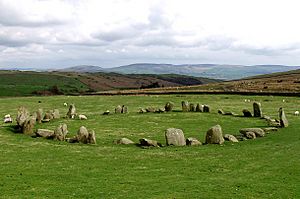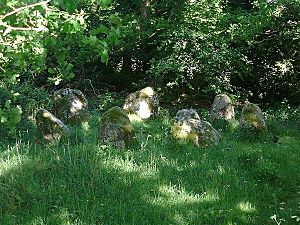Stone circle facts for kids


A stone circle is a very old monument made from several large, upright stones. These stones, often called menhirs, are usually arranged in a circular or oval shape. The number of stones in a circle can be as few as four or as many as sixty. Sometimes, ancient burial sites are found inside or very close to these stone circles.
There are about 1,000 stone circles and 80 stone henges in Great Britain and Ireland. Scientists believe these circles were likely used for special rituals or ceremonies. Some stone circles might have also worked like ancient calendars. This is because certain stones in these circles line up with the sun or moon on important dates, like the summer solstice.
Contents
What are Stone Circles?
Stone circles are fascinating structures built by people long ago. They are made from large, natural stones that were carefully placed upright in the ground. These stones are often very heavy and tall. The way they are arranged, usually in a circle or an oval, suggests they had a special purpose.
The size of stone circles can be very different. Some are small with just a few stones, while others are huge with many stones covering a large area. Many of these ancient sites are found near places where people lived or buried their dead. This connection to burials makes us think they were important for communities.
How Were They Built?
Building a stone circle was a huge task for ancient people. They did not have modern machines to help them. Instead, they likely used simple tools and a lot of teamwork. They would have moved the massive stones using rollers, ropes, and ramps. Then, they carefully lifted each stone into an upright position and secured it in the ground. This shows how skilled and determined these early builders were.
Where Can You Find Stone Circles?
Most stone circles are found in parts of Europe, especially in Great Britain and Ireland. These two countries have the largest number of known stone circles in the world. You can also find them in other places like France, Portugal, and even parts of Africa. Each region often has its own unique style of stone circle.
Stone Circles in Britain and Ireland
In Britain and Ireland, stone circles are a common sight in the countryside. They are often found in open fields or on hills. Some famous examples include Stonehenge in England and the Drombeg stone circle in Ireland. These sites attract many visitors who want to learn about their ancient history. The large number of circles in these areas suggests they were very important to the people who lived there thousands of years ago.
What Were Stone Circles Used For?
The exact reasons why ancient people built stone circles are still a mystery. However, experts have several ideas based on what they have learned from studying these sites. The most common theories suggest they were used for rituals, ceremonies, and possibly as calendars.
Stone Circles and Ancient Rituals
Many historians believe that stone circles were important places for ancient rituals. These rituals might have included religious ceremonies, gatherings, or special events for the community. The circular shape could have created a sacred space, separating it from the everyday world. People might have met there to celebrate harvests, honor their ancestors, or make important decisions.
Stone Circles as Ancient Calendars
Some stone circles are built in a way that lines up with the sun or moon at certain times of the year. This suggests they might have been used as giant calendars. For example, on the summer solstice (the longest day of the year), the sun might rise or set directly over a specific stone. This could have helped ancient people track the seasons, which was very important for farming and knowing when to plant or harvest crops.
Tracking the Sun and Moon
The careful alignment of stones with the sun and moon shows that ancient people had a good understanding of astronomy. They observed the sky closely and used these observations to mark important dates. This knowledge would have been passed down through generations. These stone calendars helped them organize their lives and plan for the future.
Images for kids
-
Easter Aquhorthies stone circle near Inverurie, Aberdeenshire, Scotland.
-
Drombeg stone circle, County Cork, Ireland.



